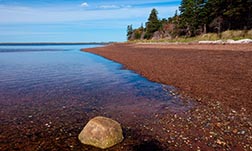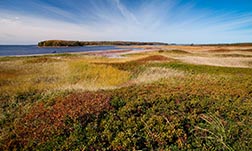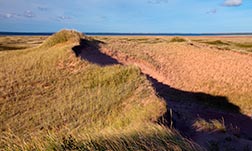
© Epekwitk Assembly of Councils
What a national park reserve in Pituamkek (Hog Island Sandhills) means
The protection of the Hog Island Sandhills carries incredible meaning for many people. The First Nations of Prince Edward Island, the Government of Prince Edward Island, and the Government of Canada agree the undertaking of a feasibility assessment is merited, and an important step toward the lasting preservation of the area.
Protecting this area means Canada takes one more step towards achieving its goal of protecting 25 percent of the nation’s land and water by 2025. If established, a new national park reserve in the Pituamkek (Hog Island Sandhills) would represent and protect culturally significant First Nations heritage locations, geologically significant features, and important ecological habitats.
What this means for the area and for the Province of Prince Edward Island is the addition of an important officially-protected area. It means more research into coastal erosion, and more emphasis placed on understanding the impacts of climate change on the shores of PEI. It means the protection a 50-kilometer-long string of barrier islands along the northwestern coast of PEI.
For the Mi’kmaq, it means the protection of not only the barrier islands, but important cultural and historical heritage. The Pituamkek (Hog Island Sandhills) area is fabled in Mi’kmaq culture and stories of the islands reach back generations. Home of multiple archaeological sites, rare geological formations, and ceremonial lands, protecting Pituamkek means ensuring that the Mi’kmaq connection to these ancestral lands is not only recognised, but supported, preserved, and fostered.
Parks Canada is working with the Mi’kmaq First Nation governments and the Government of Prince Edward Island to conduct a feasibility assessment for the potential establishment and management of the proposed new national park reserve in Pituamkek (Hog Island Sandhills).
The potential benefits of a national park reserve in the Pituamkek region
- Conservation and protection
-
- The conservation of one of Eastern Canada’s most unique coastal habitats – one which has played a significant cultural role for Mi’kmaq communities for thousands of years
- Increased protection of federally and provincially listed species at risk and their habitats including, but not limited to; the little brown bat, the northern long-eared bat, the piping plover, and the Gulf St. Lawrence aster
- Protection of a significant and diverse region of our country facing the effects of climate change
- The protection of natural and cultural resources of the lands through Parks Canada’s management program and mandate to foster public understanding, appreciation, and enjoyment
- The management of activities within the proposed national park reserve in a more ecologically holistic manner
- Relationships
-
- Strengthen the relationship between the Governments of Canada, Prince Edward Island, and the Mi’kmaq People of Prince Edward Island through a new partnership
- Help to preserve Mi’kmaq cultural land use traditions
- Consult on the park concept development process with a different focus aligned to organizations’ priorities all leading to a common goal – the protection of the Pituamkek area
- Economic opportunities
-
- Provide opportunities for residents and visitors to continue to experience and appreciate this environment
- Encouragement of ecologically sustainable economic opportunities in the region
Timeline
Find out where we are in the journey of creating a national park reserve in Pituamkek.
More information
Related links
- Public engagement survey and consultations summary
- Memorandum of understanding for proposed National Park Reserve in Pituamkek (Hog Island and the Sandhills)
- Help shape the future of a new national park reserve in Prince Edward Island
- Pituamkek National Park Reserve
- Government of Canada and PEI Mi’kmaq First Nations working together to protect the Pituamkek (Hog Island Sandhills)
- Canada’s National Parks System Plan
- Canada National Parks Act
- L’nuey: the Mi’kmaq rights-based initiative
- Date modified :



